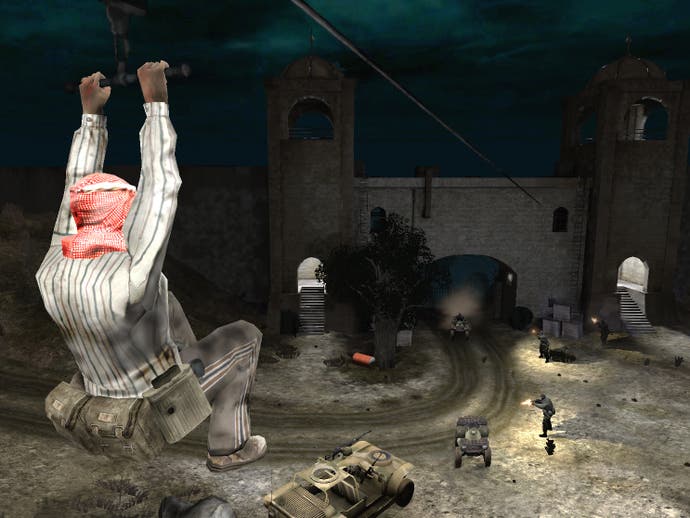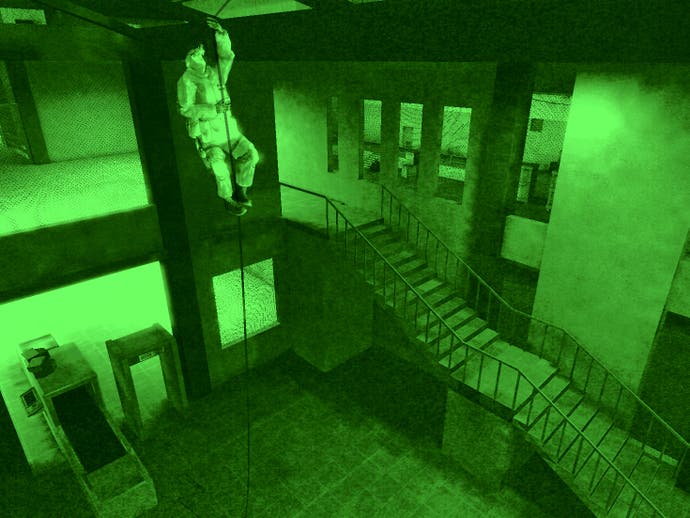Battlefield 2: Special Forces
Special? How special?
Time for a diversion until we get to the review? Oh, I think so. Press page down a couple of times if you want to skip the history lesson. Everyone else: leave your pencil alone and don't take notes. I won't be asking questions later.
Battlefield 2: Special Forces is a little different while remaining exactly the same. Just as contented lovers silently transform into hate-filled animals, their bristling manner toward each other somehow eluding the cursory detection skills of an outsider, Battlefield's priorities have started to shift and change. Though unlike the doomed relationship, not necessarily in a bad way.
(For anyone other than marriage councillors anyway.)
Battlefield's origins lie in the relatively obscure first-person shooter Codename Eagle, which was released, received lukewarm-to-terrible reviews and then proceeded to be forgotten by everyone in the entire world. Except for the two important groups of people - the developers and the fans. The developers still loved it, and the fans had realised that Codename Eagle's multiplayer achieved something that no other game had really managed at the time. It had integrated vehicles into a multiplayer environment beautifully, and they were having crazy fun on their own servers going mad by skidding trucks around and similar. In fact, showing themselves to be a really devoted fanbase, they got a little radical.
While the idea of fan communities making their own videos to show off their games is really commonplace now, one of the first I actively remember raising my eyebrows at was for Codename Eagle. Tight cuts of vehicular stunts and craziness? Hell, I could go for this. What's the game? Codename Eagle? That thing with the rubbishy first level from last year? Pull the other one.

Codename Eagle was, effectively, Battlefield 0 and its multiplayer the grounding for Battlefield 1942. Seeing what had captured the fan's imagination, Battlefield 1942 understood exactly what it was going to do. It was going to be the online shooter that was about the vehicles. Sure, being a soldier was fine, but the core mechanic was that anything you saw, you could hop into and take control. Aircraft, tanks, trucks and foot soldiers all seamlessly integrated into a whole. BF1942 was about an integrated war. It was awesome. It sold (oooh) a lot of copies.
Then Battlefield: Vietnam, which added helicopters, and... er... doesn't fit well into this theory, but if we move swiftly on no-one will notice.
Then Battlefield 2, which pushed things forward again. With a few months' hindsight it's actually best noted for how it changed design direction. Previously, they knew what they existed for - Battlefield was the game about the vehicles. And sure, the vehicles remained in the sequel, with some of the largest physical elements removed (Aircraft Carriers, for example) and some control issues changed. But in terms of actually making a difference to how the game played, it was the commander and squad organisations that rejuvenated it; forming a squad of men, and operating under tight co-ordination. A commander setting these waypoints for the teams - usually of infantry - to pull together.
In short, it had become a game about small-group teamwork rather than craziness on wheels or beneath rotorblades. Sure, the vehicles could often dominate the game - we've all being strafed to death by a helicopter or eight - but the focus on what was interesting had moved.
And, in a roundabout way, we reach Battlefield 2: Special Forces, which continues the trend. On average, the maps are more intense, focused and urban with less wide-open terrain to wander. While new choppers are available, on most maps they dominate less. It's an interesting move. While it's still a fascinating game, extrapolate this and you end up with a very different thing from what originally enchanted us about Battlefield 1942.

That said, in this pack closer attention on infantry makes more sense given the game's subtitle. The Special Forces are essentially the ultimate infantry in the modern general's arsenal. You didn't get the SAS abseiling in a tank down the front of the Iranian Embassy back in the counter-terrorist day. However, if you come expecting a radical reworking of Battlefield's mandate, you're in for a disappointment. While the sides are various counter-terrorist groups (SAS, Spetnatz, Green Berets, The Girl Guides) and Evil Members Of The Axis Of Evil (Insurgents, Terrorists, obsessive-single-next-generation-format advocates), expect the same flag-capturing conquest style of play. It isn't Rainbow Six or anything similar and rare that you actively feel like a highly trained specialist.
Rare, but not completely unheard of. When you do, it's generally to do with the new toys given to you. The three most atmospheric are the night-vision goggles, the zip-lines and the grappling hooks. The former are only equipped on the game's night levels, where the vast majority of the map is plunged in inky darkness. Activate the goggles and you enter a world of green, and lose your peripheral vision. Click on, and scamper after your team-mates and it immediately changes the tone of the encounter. The loss of visibility at night seems to divide players - though aren't players always divided over their map preference? I'm very much towards the pro. Emerging from the darkness as part of an organised troop for a clinical strike before heading back off is gloriously reminiscent of the WW2 SAS hit and run attacks in the North African Campaign.
Sorry. Came over all History Channel then.
Not that it's perfect. It includes the most bemusing design decision of the whole game, in that the night vision is attached to a battery. Use for too long and it'll run out of power, requiring you to go without while it powers up. This would perhaps be acceptable if there were many well-lit areas to stick to while it did so, but there aren't. Pitch Black is very much this season's colour in map design. This means that if you're playing well and surviving without doing anything stupid like having a small piece of metal fly through your head, eventually you're going to have to sit twiddling your thumbs while the gauge recharges. Completely bewildering to enforce tedium on the player for something they essentially have to use - especially when there's the disadvantage to using the night vision goggles of being incredibly vulnerable to anyone who lobs one of the new flashbang grenades. Available to any Special Forces soldiers, these blind people even in normal conditions. If you've had your eyesight heightened via a cunning machine you can imagine how incapacitated you are by the sudden light.
The grappling hook and the zip-line are less troublesome, and act as the what-goes-up-must-come-down pair. If you want to ascend, you'll turn to an Assault or Anti-tank soldier with the hook, who can lob it up and allow everyone to shimmy up to a rooftop or over a wall. Want to descend, and the zip-line can be fired by Sniper and Special Forces to a lower surface - for example, from the rooftop to the street below - and have people do the old Krypton Factor death-slide downwards. If you're in less of a rush, you can use the grappling hook too, dropping and clambering down. All add manoeuvrability to a co-ordinated team and allow some genuinely cunning thinking by a tactically aware soldier. That a team is the proverbial sitting duck when using them makes sure they're not overused, too.

Since we've already dealt with the flashbangs, the addition of tear gas is another tactical element for would-be storming parties. The Support kit is able to fire rounds of the canisters, filling an area with the fumes and causing a lovely blurred vision and coughing effect. Pulling on a gasmask can circumvent the worst of the effects, but the time they take to recover is enough for deadly force to be applied. That is, shootage.
And while this is primarily about the infantry and close fighting, there's a selection of new vehicles to drive. The flyboys will be placated by the HIND and a nifty Apache gunship, but I've most affection for the slightly more rubbish vehicles. The one-person ATV is a nippy rugged vehicle, perfect for quick tactical manoeuvres and the jet-ski allows would-be heroes to recreate the greatest scenes from Thunder in Paradise. Did they have a jet-ski? Oh, I'd imagine so.
Bar the bizarre nightlight decision, the biggest problems of Battlefield 2: Special Forces are the biggest problems of Battlefield 2. Problems with loading speed? Don't expect a solution here. The game-select browser remains one of the more horrible in any major game. However, the most aggravating thing about the game is that as soon as the expansion has been released they release a new patch for the game: a 280Mb patch which needs to be downloaded and installed before you can play on a server. From their site, at 6 to 8Kb per second, it was a good half-day or so from installing it to playing it. You'd hope that if someone was shipping a mission pack on an enormous DVD they'd have at least waited until they'd finished the patch and included it, but it seems that the unseemly rush to the shop has prevented such politeness.
Still, this disrespect of the customer aside, there's little to object to in the mission pack. Effective, brutal and full of hard-as nails military posture, it's a decent expansion pack to one of the best games of the year. It solves some of its problems - the lack of maps being a main bugbear - and adds a few more new toys to keep the militar-o-philes happy. Career soldiers won't be disappointed and those considering a second tour of duty have enough incentives to head back into the field.

